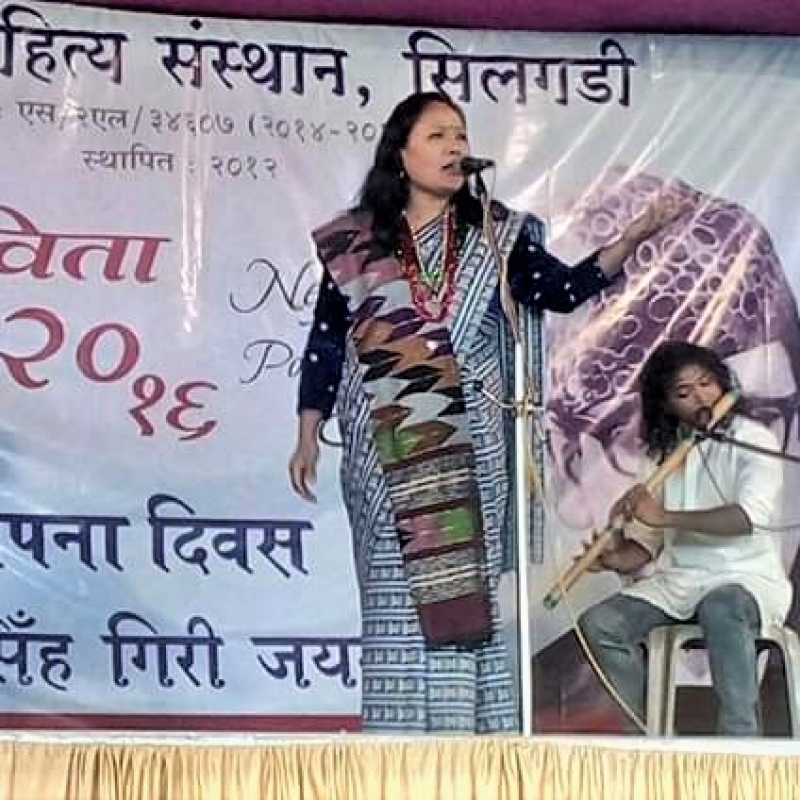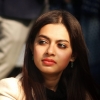Dhamari is a poetry competition that was conceptualised by Nepali Sahitya Sansthan, Siliguri, West Bengal, in 2015. The literary organisation held a Dhamari every year until 2017 to promote Nepali poetry in the Indian Nepali community. The first Dhamari was held on December 26, 2015, at Dr I.B. Thapa N. Vidyalaya School, Pradhan Nagar, Siliguri, followed by the second Dhamari on December 27, 2016 at Naxalbari High School, Naxalbari, Siliguri, and the third on December 27, 2017 at New Rangiya, Shiv Mandir, Siliguri. All the three Dhamaris have been held around the same date every year to commemorate the birth anniversary of one of the most eminent Nepali poets, Agam Singh Giri (1927–1971).
The primary reason behind the conceptualisation of Dhamari was to facilitate the journey of a poem from the page to the stage. Many Indian Nepali litterateurs are of the opinion that poetry is neglected both within and outside the Indian Nepali community and as a result does not get the same amount of attention as the Nepali novel or the short story, which remain the more popular genres. The purpose of Dhamari was to bring Nepali poetry back into the mainstream by attempting to inform the people about the aesthetics and the nuances of the genre. The creators of the platform believed that popularising the genre of poetry within the community would be the first step towards its dissemination outside the Darjeeling Hills. They also realised that one of the best ways in which the genre of poetry can be made popular is through poetry performances, a form that would allow people to engage with the intended message of the poems without having to access the written text.
Creating a Tumult Within the Indian Nepali Community
Dr Ganashyam Nepal, professor at the Department of Nepali, North Bengal University, Siliguri, West Bengal, and a founding member of the Dhamari organised by the Nepali Sahitya Sansthan, Siliguri, says that ‘in the western part of the Indian subcontinent, especially in Rajasthan, the word dhamari means taal (rhythm),’ however, in the Darjeeling Hills, Sikkim, and the rest of the Nepali-speaking world, dhamari is used in the sense of ‘creating a tumult’.[1] Dhamari organised by Nepali Sahitya Sansthan remains true to its literal meaning in the region; in a sense, it creates a tumult in the very nature of the genre of poetry by bringing together poetry and performance.
Dhamari has set off the careers of many Indian Nepali performance poets of today, including Pavitra Lama, Vikki Thapa (from Kalimpong, West Bengal), Chetna Tamang (from Mirik, West Bengal), and Kritika Dahal (from Darjeeling, West Bengal). Lama, Tamang and Thapa were the winners of the Dhamaris of 2015, 2016 and 2017, respectively, and Dahal was the first runner-up of the Dhamari held in 2017.
In an interview conducted on January 14, 2019, Basudeo Thapa, assistant professor, Department of Nepali, Kalipada Ghosh Tarai Mahavidyalaya, Bagdogra, West Bengal, and Devchandra Subba, assistant Professor, Department of Nepali, Sikkim University, Gangtok, Sikkim, who are members of the organising committee of Dhamari, say that the primary purpose of the platform is ‘to keep alive the aesthetics of poetry by bringing poetry form out of the text to in front of the audience.’[2] They go on to add: ‘the platform has always ensured that the poems performed have a distinct Indian Nepali essence’. Dhamari is mostly conducted in an open space with the belief that nature is the best stage.
Critics and researchers working in the field of performance poetry have often believed that the stance taken by Dhamari is a political one since most Nepali poems composed in India deal with issues related to identity and identity crises. However, Basudeo Thapa and Devchandra Subba clarify that the platform has always advocated poems that ‘portray the flavour of the folk’ and poems that have an Indian Nepali essence from a cultural point of view as opposed to a political point of view. Over the years, Dhamari has brought up many socially relevant issues. The competition was also made theme based to accommodate a variety of issues that needed a public platform. The theme for Dhamari, 2017, was child labour and a total of 19 participants performed in this competition.
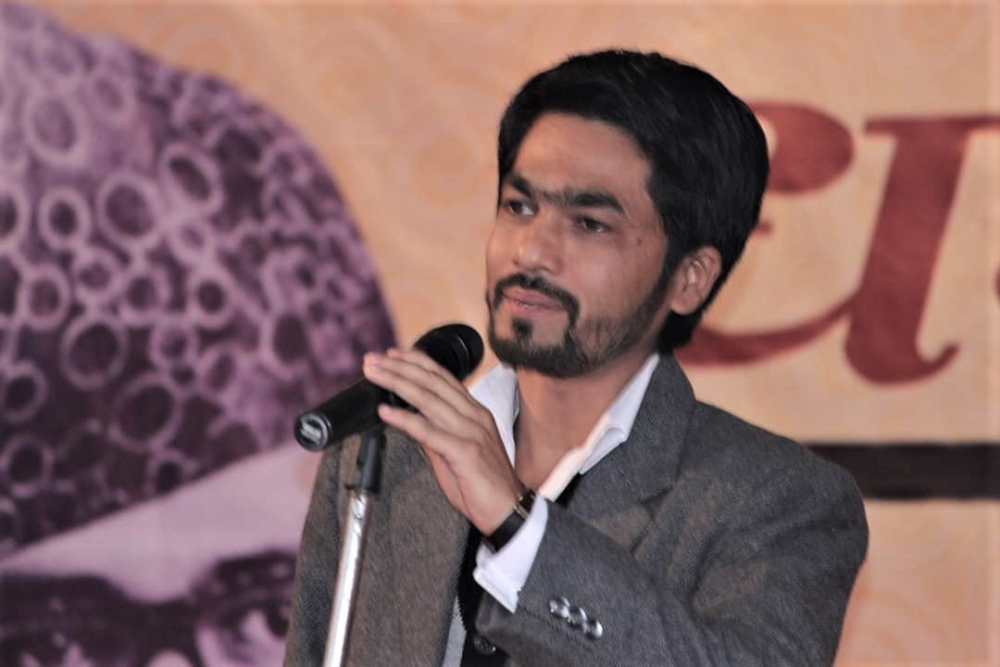
The main reason behind bringing poetry into a public forum through Dhamari was to challenge the common perception regarding the genre that reading and appreciation of poetry requires formal training and therefore, is not for ordinary people/readers. A platform like Dhamari also challenges the notion that only those who have access to formal education through schools and colleges can engage with poetry.
This belief completely overlooked the early phase of development of Indian Nepali poetry that had its beginnings in the once popular lyrical forms of jhaurey, lahari and sawai which were composed primarily by soldiers and tea garden workers. Eminent Nepali litterateur, Jiwan Namdung (born in 1951) writes in his book, History of Modern Indian Nepali Literature (2019) how these popular forms were composed by people ‘with some literacy but endowed with the ability to compose impromptu verses and lines’ which were ‘high in lyrical sentiments’.[3] Over time, these oral lyrical forms started to disappear as poetry came to be confined to the written domain. However, a major section of the Indian Nepali population does not have access to the written word even today, and still mostly works as manual labourers and tea garden workers.
Dhamari resolves to lay the basis for performance poetry within the Indian Nepali community by bringing back these popular lyrical forms of yore. The creators of the platform wanted to bring back poetry into relevance by reminding the people about the aesthetics of the genre. Dhamari was an attempt to tell people within the Indian Nepali community that poetry need not always be read, it can be recited, sung or even performed in the way jhaurey, lahari, and sawai were once sung and performed in the larger sense.
Dhamari vs Slam Poetry
Even though Dhamari is similar to slam poetry competitions of the West, it has a distinct local essence both in terms of the central theme that is announced every year and the variety of poems that the platform accepts. Further, while the idea behind Dhamari and the slam poetry movement was similar, the primary point of departure for Dhamari is that it is first and foremost a competition and there are no two ways about it as opposed to poetry slams where ‘competition may not be the point, but is an essential ingredient.’[4] In the West, primarily in the United States, where poetry slams or slam poetry originated, there is still some amount of confusion regarding whether slam is analogous to competitive poetry or not. In the words of Marc Kelly Smith, the founder of the poetry slam movement in America, ‘slams are captivating poetry events that focus a live audience’s attention on the presentation of poetry that’s been composed, polished, and rehearsed for the purpose of being performed—very often in a competitive arena, but not always.’[5] This means that slams can be held anywhere—in a competitive arena, a carnival, a classroom, a church or even in a meeting hall as long as there is an audience—thus making the presence of a live audience the most significant marker of poetry slams. Therefore, what is no longer a matter of debate when it comes to poetry slams in the West is that the format aims to communicate poetry in a public forum to be able to connect with the audience directly. In this regard, Smith states how during a poetry slam, ‘the audience is prompted to get involved’ which it mostly does.[6] Apart from the presence of an audience, slam gives equal importance to the text of the poem and its presentation or performance. Smith says, ‘slam poetry is performance poetry, the marriage of a text to the artful presentation of poetic words onstage to an audience that has permission to talk back.’[7] For the performance to be successful, the poet relies on memorisation and rehearsal.
Regarding the conceptualisation of the poetry slam movement, Smith agrees to have hosted the first poetry slam at Get Me High Jazz Club in Chicago in 1984 out of an urgent need to ‘liberate poetry from the page’ which he believed only catered to ‘the intellectually elite’, had become ‘almost impossible to understand’, and was thus accessible only to a select few.[8] Many Indian Nepali litterateurs, including the founders of Dhamari, were of the same opinion and felt an urgent need to make poetry accessible to the masses. Therefore, just like Smith gave a new life to poetry by giving it a microphone and a stage, the Dhamari offered Indian Nepali poetry a stage, a microphone and an audience.
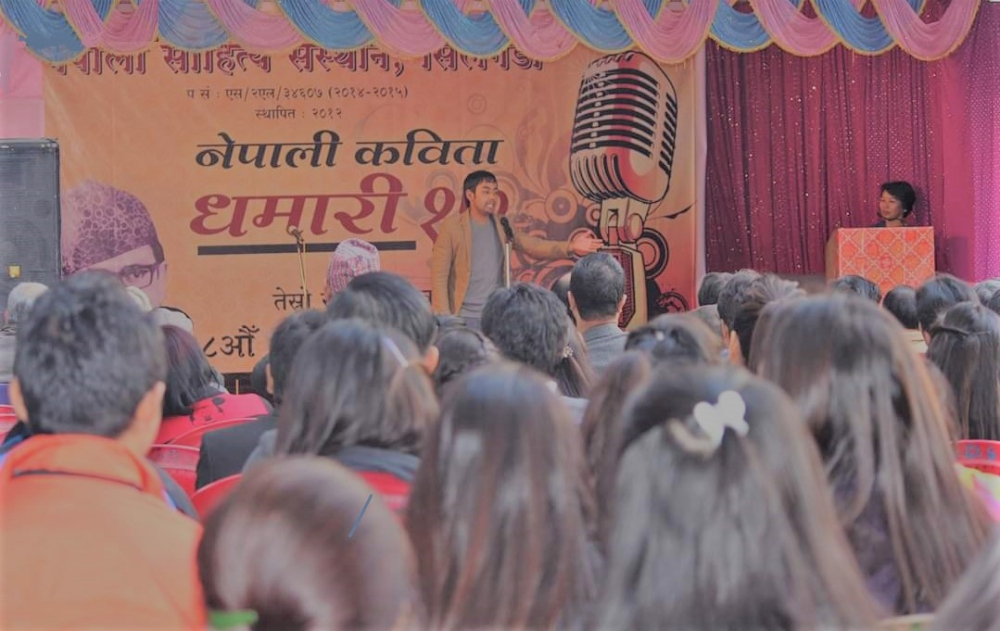
Process of Evaluation
Basudeo Thapa and Devchandra Subba stated that the panel of judges consists of senior poets as well as people from other fields. The process of evaluation usually happens in two rounds. In the Dhamari held in 2017, Padam Chettri and the Indian Nepali poet Udaya Thulung were the judges who judged in deliberation with the guest judges, Edwin Rohong, CM Chudamani and the famous Indian Nepali litterateur Mohan Thakuri. The chief guests, Rajendra Dhakal, principal of Kalimpong College, West Bengal, and the renowned poet Sudha M. Rai, as well as the special guest, poet Bhavilal Lamichhane were also consulted during the process of evaluation.
Even though the founders of Dhamari do not accept slam poetry of the West to be their primary influence, it is difficult to ignore how like in the West, where the poet-performer has to prove their ‘superiority as both poet and performer’, both the poem and its performance are given equal importance in the Dhamari as well.[9] It is mandatory for the poems that are performed to be original and the poet’s own composition. Judging depends on the following factors:
a) The poem—its form and content
b) The presentation of the poem—factors such as diction, pronunciation, intonation, and the mode of presentation
Over the years, Dhamari has encouraged various kinds of poetry performances, whether it is poetry recitations, or poetry involving abhinaya or sangeet (in the broader sense, acting, and music respectively) or both. However, over time, performances involving abhinaya and/or sangeet have been given more preference by the organisers of the platform with their belief that mere poetry recitations create an apparent disjunction between the poet and the stage. Lack of intonation, gesture and for that matter, even facial expressions in most poetry recitations tend to make any poem lifeless during its performance, thus failing in its larger purpose of drawing the attention of the audience towards the poem, which is the primary agenda of the creators of Dhamari.
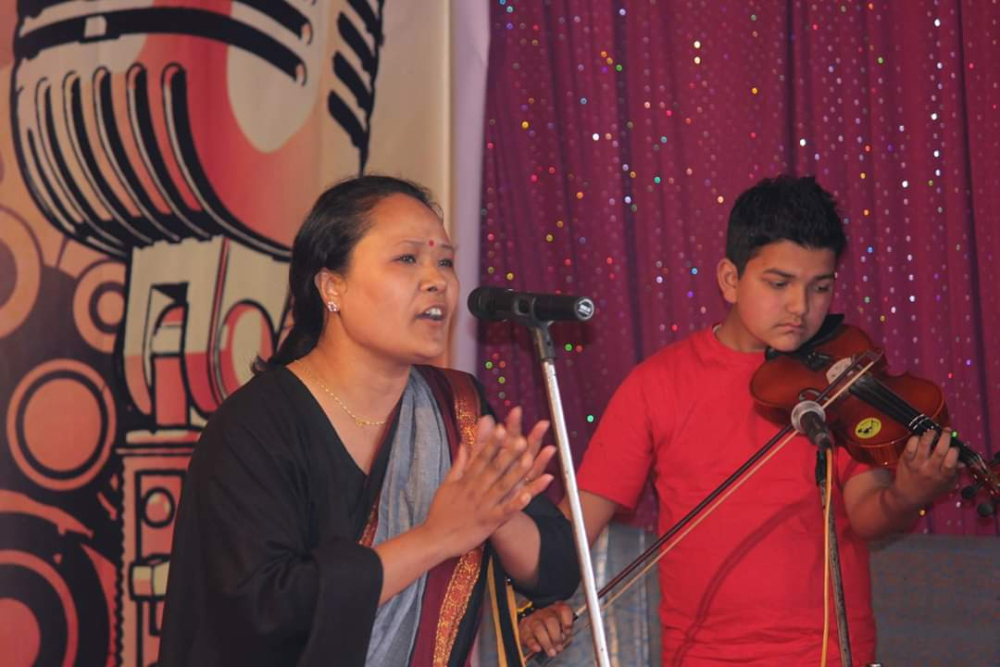
On the whole, Dhamari has been instrumental in evolving and expanding the scope of Indian Nepali performance poetry in the Darjeeling Hills and Sikkim. It has also been the moving force behind the sudden surge in Indian Nepaliperformance poetry since the middle of the 2010s. The most significant contribution of the platform has been to bring the emerging genre of avisangi (a form of performance poetry that derives from the terms abhinaya and sangeet), spearheaded by Lama, to the forefront. Lama has herself acknowledged time and again how there was no looking back for her since avisangi came into the public eye for the first time in 2015 when she won the first Dhamari. According to Lama, every section of the Indian Nepali society and beyond, irrespective of age, class, caste, gender and religion, has been receptive to the genre and has thoroughly enjoyed every Avisangi performance of hers.[10]
Dr Nepal said that he and the other founders and organisers of the platform were optimistic about the future of Dhamari and wanted to take it outside the Darjeeling Hills. They had the desire to organise a Dhamari in Sikkim after 2017, but the plan could not be brought to fruition due to lack of funds and other resources. However, seeing the zeal of both the organisers and the participants, one might feel that such obstacles are no match for the sense of commitment that they share with Dhamari.
Notes
[1] Dr Ganashyam Nepal, in conversation with the author, Department of Nepali, North Bengal University, Siliguri, West Bengal, January 14, 2019.
[2] Basudeo Thapa and Devchandra Subba, in conversation with the author, North Bengal University, Siliguri, January 14, 2019.
[3] Namdung, History of Modern Indian Nepali Literature, 5.
[4] Smith and Kraynak, Take the Mic: The Art of Performance Poetry, Slam and the Spoken Word, 28.
[5] Ibid, 26.
[6] Ibid, 27.
[7] Ibid, 28.
[8] Ibid, 36.
[9] Ibid, 27.
[10] Kabir Basnet and Pavitra Lama, in conversation with the author, Darjeeling, April 5, 2018.
Bibliography
Namdung, Jiwan. History of Modern Indian Nepali Literature. Delhi: Sahitya Akademi, 2019.
Smith, Marc Kelly, and Joe Kraynak. Take the Mic: The Art of Performance Poetry, Slam and the Spoken Word. Illinois: Sourcebooks, Inc., 2009.
The DC News Desk. ‘Vikki Thapa, Winner of Nepali Kavita Dhamari 2017.’ The Darjeeling Chronicle, December 27, 2017. Accessed April 19, 2020. https://thedarjeelingchronicle.com/vikki-thapa-winner-nepali-kavita-dhamari-2017/.
